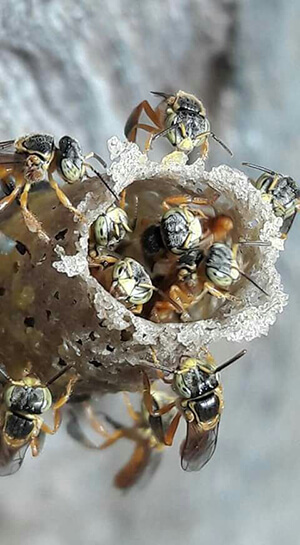
Stingless bees aren’t present in the United States, but they’re native to tropical areas such as Mexico and Central America. These social bees come in many shapes and sizes and can be very beautiful (see Photos 1-3).
Some species of stingless bees, including Melipona beecheeii (see Photo 4), have been domesticated since at least Mayan times (i.e., ~4,000 years ago) and are managed for their hive products. Their honey is a prized commodity, often selling for 4-5 times as much as honey produced by the western honey bee, Apis mellifera. I’ve tried honey from several stingless bees and can confirm it’s delicious, though some varieties are only for the adventurous. All varieties taste quite different from Apis honey.
The western honey bee was introduced to North America in 1622 and to Mexico and Central America a bit later, probably the mid to late 1800s (Carpenter & Harpur 2021). So western honey bees and native stingless bees have existed together in the tropics for about 150 years. As mentioned in previous Notes from the Lab columns, there’s currently lots of interest among beekeepers, conservationists, and land managers regarding the impact that managed honey bees can potentially have on native bees via competition for resources and sharing of diseases. See for example the November 2021 and September 2022 columns, 161(11):1225-1227 and 162(9):1025-1027, respectively.
Nearly all research on disease spillover from honey bees to native bees has focused on temperate bumble bees (Bombus spp.) as the disease recipient. But what about other bees from other regions? Do tropical stingless bees share viruses with honey bees? Do these viruses “spill over” from honey bees and cause elevated mortality in stingless bees? If so, what can beekeepers do to minimize impacts on native stingless bees? These are the topics for the sixty-seventh Notes from the Lab, where I summarize “Trouble in the tropics: Pathogen spillover is a threat for native stingless bees,” written by Fernando Fleites-Ayil and colleagues and published in the journal Biological Conservation [2023].
For their study, Fleites-Ayil and colleagues collected honey bees (Apis mellifera) and stingless bees (Melipona beecheeii) from twelve locations throughout the Yucatan Peninsula (see Figure 1). They brought the bees back to the lab and screened 9-10 of each species at each site (234 bees total) for six RNA viruses: acute bee paralysis virus (ABPV), black queen cell virus (BQCV), deformed wing virus (DWV genotypes A and B), sacbrood virus (SBV) and slow bee paralysis virus (SBPV).
To check the genetic identity of BQCV, the most prevalent virus in their bees, the authors sequenced a viral fragment from all bees that were positive for BQCV from seven locations. In total, virus genotypes were sequenced from 11 Apis and 13 Melipona adults.
Finally, to assess whether the viruses caused Melipona to get sick and die, the authors 1) injected pupae with BQCV, DWV-A or DWV-B and tested whether each virus caused an active infection, and 2) fed adults an inoculum of BQCV, DWV-A or DWV-B and monitored whether the bees died more quickly compared to bees fed an uncontaminated control inoculum.
So, what did they find? Did stingless bees share viruses with honey bees? Yes. Across all sites, the virus with highest prevalence in both Melipona and Apis bees was BQCV (see Figures 1 & 2). Both species of bees also had some individuals who were positive for DWV-A, but only two Apis bees from the entire study were positive for DWV-B (see Figure 2 center and right panels).
When looking at quantitative loads, BQCV viral titres were higher in Apis bees (range 103-107 genome equivalents per bee) compared to Melipona bees (102-105 genome equivalents per bee). DWV-A titres in Apis bees were variable (102-108 genome equivalents) and the only Melipona bee positive for DWV-A had a titre of 105 genome equivalents. The titres of the two Apis bees positive with DWV-B were low (103 genome equivalents).
Were the same genotypes of BQCV present in stingless bees and honey bees? Yes and no, depending on the location. At some locations, the BQCV genotypes found in Melipona were identical to the genotypes found in Apis. At other sites, distinct genotypes were found in each species.
Can stingless bees be infected with BQCV, DWV-A, and DWV-B and do these viruses have negative impacts on them? Unfortunately, yes, yes, yes, and yes. Each virus was able to quickly replicate and reach 106-107 genome equivalents in Melipona pupae within 3-5 days post-inoculation. When Melipona adults were fed inoculum containing BQCV, DWV-A, and DWV-B, they died 14% faster (see Figure 3; survival of virus-inoculated bees = 6 days on average, compared to survival of control-inoculated bees = 7 days on average).
Well that’s troubling. What does all of this mean for spillover of disease from honey bees to stingless bees, and what can beekeepers do about it? Through multiple lines of evidence, the study by Fleites-Ayil suggests that spillover of viruses from Apis to Melipona is occurring and Melipona is being harmed. Prevalence and loads of viruses were greater in Apis than Melipona, which is consistent with a pattern of spillover from Apis to Melipona. Some BQCV genotypes were identical in both Apis and Melipona, indicating sharing of virus strains, while other genotypes were unique in Melipona, suggesting viral evolution within Melipona post-transmission. Finally, Melipona became sick and died faster when exposed to BQCV, DWV-A, and DWV-B that were sourced from Apis.
Obviously none of this is good news for Melipona. But do not despair, there is hope! The main way that honey bees get sick with viruses is from inadequate control of the varroa mite. Deformed wing virus (DWV) and acute bee ….


